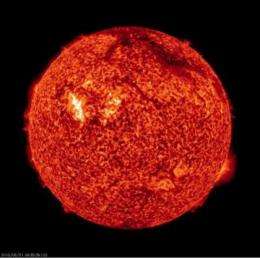3D modeling of the Sun from the core to the surface

A team at the Astrophysics, Instrumentation and Modeling Laboratory (CEA/CNRS/Université Paris Diderot) has successfully modeled, in 3D, the effects of gravity waves in an extremely comprehensive simulation of the Sun, from its nuclear core to its convective surface. The results make very highly precise information accessible and provide a rigorous and unprecedented description of the Sun's internal dynamics. This research, published in Astronomy and Astrophysics, should make it possible to substantially refine theoretical models and to plan future space missions (Solar-Orbiter, Plato) to observe solar-like stars more efficiently.
The waves which propagate within stars, in this case the Sun, influence their structure, their dynamics and how they evolve. Since they can generate global pulsations, they provide us with precious information for studying dynamic phenomena within stars. There are two types of these waves:
- acoustic waves, which are exactly the same as sound waves;
- and gravity waves, which propagate in any density-stratified fluid, without large-scale (macroscopic) convective motion.
These waves play an important role in changes in the rotation and mixing of chemical elements within the deep layers of stars similar to our Sun. Like acoustic waves, gravity waves can, depending on their frequency, resonate within the Sun in what are known as "g modes": this produces the same phenomenon as that seen with a guitar string, which resonates according to certain harmonics and its own specific modes.
Thanks to the nonlinear simulations carried out by the Astrophysics, Instrumentation and Modeling team as part of the ERC STARS 2 project , it is possible to compare the amplitude of these waves within the Sun's core and track their presence and their dynamics from core to surface. These results provide a solid base on which to refine theoretical models and open the way forward to more targeted observations, thus helping to develop increasingly more accurate knowledge of solar-like stars and how they evolve.
These simulations are not only unprecedented but also represent a genuine tour de force given the number of phenomena and the spatial scale taken into account: turbulence, convection, thermal, radiative and viscous effects, differential rotation, to name but a few. For the very first time, the results provide an extremely rich and comprehensive 3D simulation (97% of the Sun's volume) of stellar dynamics in three dimensions. From a purely numerical angle, these results are so impressive because of the ASH code, jointly developed and used by the team.
This involves high-performance simulations, requiring 5 million computing hours using the GENCI Ada computer, installed at the CNRS's Scientific Computing Resources and Development Institute (IDRIS), and 15 million hours using the Curie supercomputer made available by GENCI to the European researchers within the framework of PRACE (Partnership for Advanced Computing in Europe).
Understanding the coupling between the internal and external layers of a star
The interior of a star consists of two zones, whose dimensions depend on the star's mass.
- In the case of solar-like stars, as simulated here, the outermost zone is convective and turbulent: heat is transferred by the motion of matter, in the same way as air moves in a house heated by convection heaters.
- The inner zone is stratified and stable: it is a radiative zone in which energy is pushed outwards mainly by photons (light). Only within this stable zone can gravity waves be generated and propagate, but they are very difficult to detect from the outside since the convective zone forms a barrier which weakens them considerably.
Furthermore, how the radiative zone and the convective zone are coupled together is one of the key questions in solar Physics today, one that is a major numerical challenge given the vast range of space-time scales implied. Indeed, there are numerous phenomena to be taken into account, and they do not all occur at the same scale, but each is influenced by the others in highly complex ways.
These results open up many new prospects for exploration, such as the potential to also factor in the magnetic field and its interaction with gravity waves, and thus come even closer to reality.
More information: Theoretical seismology in 3D: nonlinear simulations of internal gravity waves in solar-like stars. L. Alvan, A. S. Brun and S. Mathis. A&A 565 A42 (2014). DOI: dx.doi.org/10.1051/0004-6361/201323253
Provided by Astronomy & Astrophysics





















